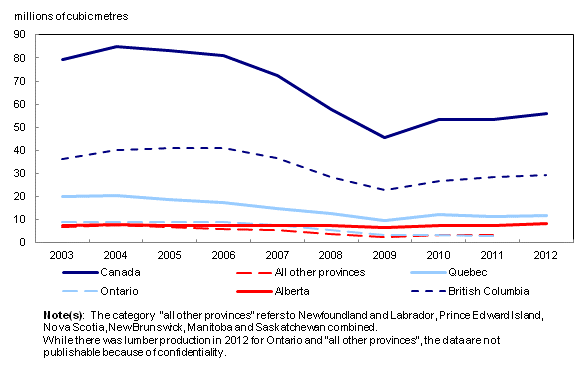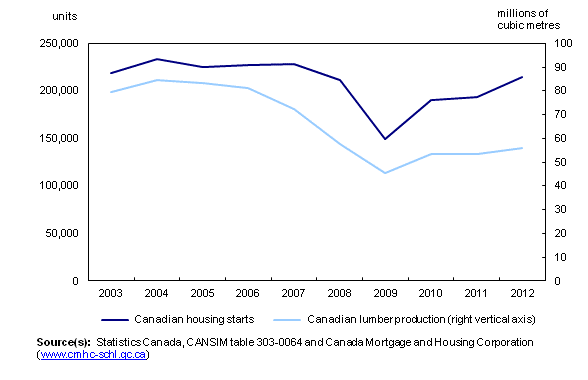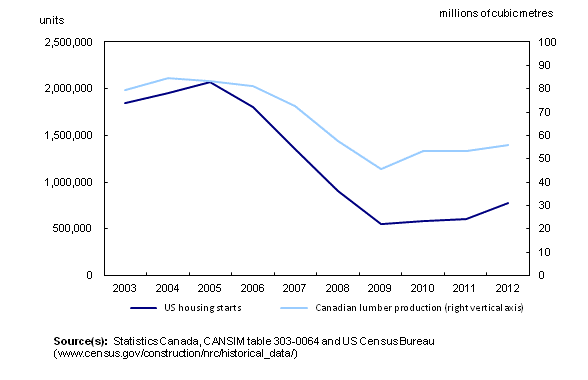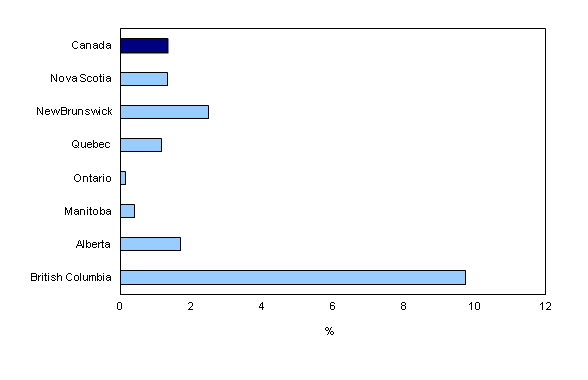Manufacturing at a glance: The Canadian lumber industry, 2003 to 2012
Archived Content
Information identified as archived is provided for reference, research or recordkeeping purposes. It is not subject to the Government of Canada Web Standards and has not been altered or updated since it was archived. Please "contact us" to request a format other than those available.
Released: 2013-11-12
Canada produced 54.5 million cubic metres of softwood lumber in 2012, up 5.0% from 2011.
Softwood lumber accounts for almost 98% of Canadian lumber production. While softwood production rose in 2012, hardwood lumber production declined 13.2% to 1.3 million cubic metres.
While Canada is home to a variety of species, the spruce, pine and fir species accounted for 90.0% of the nation's softwood production.
The top three softwood producing provinces are British Columbia, Quebec and Alberta. British Columbia (53.5%), accounted for more than half of Canada's softwood production in 2012, of which 83.1% (24.2 million cubic metres) was spruce, pine and fir.
Quebec, the second largest softwood producer in 2012, had a 20.1% share of the national total, followed by Alberta (15.0%).
Of Canada's total softwood excluding spruce, pine and fir produced in 2012, 90.1% was produced in British Columbia. British Columbia did not produce any hardwood.
Total lumber production not yet back to 2004 peak
Even with the 2012 increase, lumber production remains lower than historical highs. Lumber production hit a record high of 84.8 million cubic metres in 2004, or 34.1% higher than 2012. Since 2004, lumber production has fallen by 43.1% in Quebec and by 27.0% in British Columbia. Alberta (+4.0%) was the lone province of the top three producers to post an increase from 2004 to 2012.
Softwood lumber production and housing starts go hand-in-hand
Softwood lumber is an essential product in home construction. As such, the demand is largely driven by the trends in the Canadian and American housing markets. The United States is the largest importer of Canadian lumber and, in terms of quantity, accounted for 64.6% of Canada's lumber exports in 2012.
Canadian housing starts were up 10.8% in 2012 compared with 2011, while US housing starts rose 28.2% over the same period.
Despite the much larger increase in the US market in 2012, housing starts in Canada were back to a level much closer to their peak of the past decade. This reflects the fact that the economic downturn was not as severe in Canada as it was in the United States.
Looking at the past decade, Canadian housing starts peaked in 2004 with 233,400 units and then fell 36.1% to a low of 149,000 units in 2009 at the trough of the economic downturn. Since 2009, Canadian housing starts have been steadily increasing and stood 8.0% below the 2004 peak in 2012.
Housing starts in the United States reached their highest point in the last decade in 2005 with 2.1 million units. From the 2005 peak, housing starts fell 73.7% to an all-time low of 554,000 units in 2009. Even though starts in the United States have been gradually increasing since the economic downturn, they were still 62.3% lower in 2012 than the peak in 2005.
Total Canadian lumber production has followed a similar trend to that of housing starts in Canada and the United States. Canada's total lumber production fell 42.7% from 2003 to 45.5 million cubic metres in 2009. From 2009 to 2012, lumber production rose 22.8% to 55.8 million cubic metres.
British Columbia relies heavily on the lumber industry
Sawmill sales represented 1.3% of total manufacturing sales in 2012. Sawmill sales were above the national average in British Columbia (9.7%), New Brunswick (2.5%) and Alberta (1.7%).
Note to readers
Spruce, pine and fir species: comprises white spruce, engelmann spruce, lodgepole pine and alpine fir. Spruce, pine and fir are used primarily in residential and commercial construction.
Lumber production values for British Columbia include production values for Yukon, Northwest Territories and Nunavut.
Canadian lumber and the US housing market
The United States' share of Canadian lumber is calculated using data published by Statistics Canada in the Canadian International Merchandise Trade Database.
According to data published by the US Census Bureau for New Privately Owned Housing Units Started (annual data going back to 1959), housing starts in the United States, prior to 2008, had never been lower than 1 million units (the lowest point prior to 2008 was in 1991).
The United States' share of Canadian lumber is calculated using data published by Statistics Canada in the Canadian International Merchandise Trade Database.
Contact information
For more information, contact us (toll-free 1-800-263-1136; 514-283-8300; infostats@statcan.gc.ca).
To enquire about the concepts, methods or data quality of this release, contact Kyle Virgin (613-951-3642; kyle.virgin@statcan.gc.ca), or Tracey Capuano (613-951-7174; tracey.capuano@statcan.gc.ca), Manufacturing and Energy Division.
- Date modified:





